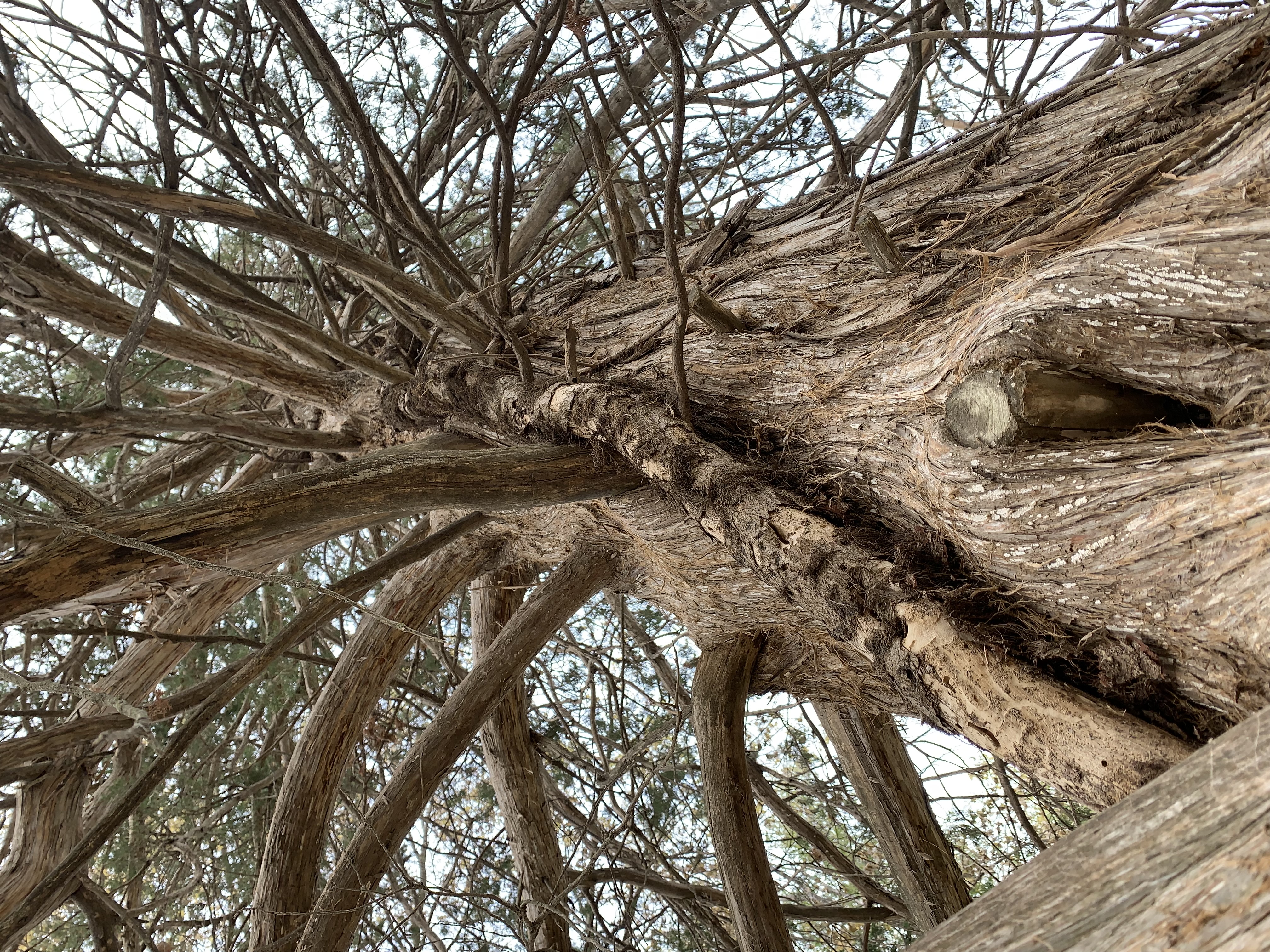Poison Ivy (Toxicodendron radicans)
As we walked through the woods on a cold January day, we came upon a cedar tree with a huge vine taking over one side of the tree. The gray, four-inch thick woody vine climbed up the tree, supporting itself on hairy, dark-brown holdfast growths that anchored it to the cedar. It was using the tree for support, and on the side of the tree taken over by the vine, the poison ivy leaves had crowded out the cedar foliage. On this January day, its telltale leaves were missing, but the vine had been growing there for years, so there was no question about what it was. Although we’re trying not to impact the woods any more than necessary, it seemed reasonable to try to get rid of the poison ivy. Getting it untangled from the tree would be a huge and unsatisfying project. We also knew better than to burn it as that can be as bad as actually touching it. So last spring Bryan took the chain saw and cut it through near the ground. Over the summer, the upper part of the vine withered, leaving space for the still-healthy tree to revamp its foliage on that side, but the vine would not be so easily defeated. Around the bottom of the tree the living, exuberant vine put out dozens of little starter plants growing up from it’s no-doubt extensive roots and rhizomes. So instead of eliminating one poison ivy vine, we created dozens.
Objectively speaking, poison ivy is a beautiful plant. In the spring, when its leaves burst from their buds, they are red, then turn to a glossy green. Summer brings on little clusters of flowers that bees are happy to pollinate. By fall, the flowers are replaced by waxy, off-white berries hanging in clusters, ready to feed the birds and squirrels. In the fall the glossy green leaves turn a bright orange, yellow or red again, offering a lovely splash of autumn color on that cedar tree.
So, what’s not to like? Well, obviously, it’s the poison part. Poison ivy, poison oak, and poison sumac, as well as the Asian Lacquer tree, all contain urushiol, a potent, clear to slightly yellow oil that causes skin irritation, rashes and blisters. Generally, we are much more concerned about identifying and avoiding it than we are about its aesthetic value. So, let’s cover the all-important identification issue.
Poison ivy can grow like ours—a big vine, or it can grow like a shrub. It is a deciduous plant, so in the winter, it presents only bare branches with tiny buds that, ironically, are shaped like hands in prayer. In May or so the red baby leaves burst from these buds. Each leaf is composed of three leaflets, with the center leaflet being longer than the ones on the sides. To remind us of these characteristics, which are consistent in poison ivy, we have the adages “leaves of three, let it be” and “long center stem—don’t touch them.” A third adage, “Hairy vine, no friend of mine” refers to the vine with its hairy appearance.
Apparently, humans are the only ones allergic to the oils. Deer eat the leaves, and birds eat the berries with impunity, in spite of the fact that the oil is present in all parts of the plant, and can remain in dead plants and leaves for a long time. Cats, dogs and horses don’t seem to react to it either, although they can carry the oil on their coats. There’s not much to do to treat the rash or blisters except wait it out, although steroids are used in severe cases nowadays.
During the early years of European presence in North America, native plants from the New World were popular in the Old. As early as 1640 poison ivy seeds were shipped to Europe where they were planted and still flourish in the English Royal Gardens at Kew and the gardens of the Faculty of Medicine in Paris. Imagine growing it on purpose! Over the centuries in the New and Old worlds, enterprising souls have sought to find medicinal uses of poison ivy and its nasty oils. In spite of the rashes, swelling and blistering that it causes on contact, medical professionals have tried treating other skin conditions such as warts with it—not recommended.
Native Americans and early settlers found other uses for the plant. Boiling parts of it produced a juice that turned black quickly, providing a black dye used in basketry. Placing a compress of poison ivy leaves on a fresh rattlesnake bite was also thought to be beneficial although I wouldn’t count on it.
A study at Duke University suggests that poison ivy flourishes in high carbon dioxide environments and predicts that we’ll be seeing more of it as the CO2 levels rise. Meanwhile, there’s plenty of it around in just about every habitat from woods and gardens to the edges of streams and trails. I haven’t encountered it personally—yet. I’m hoping I don’t!
Photo by Author

3 comments
Huh – we have those hairy vines in our yard’s wooded area but I didn’t realize they were poison ivy. It’s interesting because I’m not reactive to poison ivy at all – I ripped out about 20 shrubs from a wooded area with my bare hands and didn’t have a rash at all. Interesting that exposure like that could send some to the doctor!
Ah, but you can start reacting to poison ivy at any time of your life. It’s always best to use caution when working around it. Virginia creeper can also have hairy vines when they are large. It has five leaves and does not cause the same reaction as poison ivy.